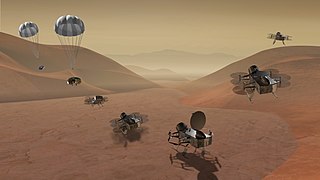
Christiaan Huygens, also spelled Huyghens, was a Dutch physicist, mathematician, astronomer and inventor, who is widely regarded as one of the greatest scientists of all time and a major figure in the scientific revolution. In physics, Huygens made groundbreaking contributions in optics and mechanics, while as an astronomer he is chiefly known for his studies of the rings of Saturn and the discovery of its moon Titan. As an inventor, he improved the design of the telescope with the invention of the Huygenian eyepiece. His most famous invention, however, was the pendulum clock in 1656, which was a breakthrough in timekeeping and became the most accurate timekeeper for almost 300 years. Huygens was an outstanding mathematician and, because he was the first to transfer mathematical inquiry to describe unobservable physical phenomena, he has been called the first theoretical physicist and the founder of modern mathematical physics.

Titan is the largest moon of Saturn and the second-largest natural satellite in the Solar System. It is the only moon known to have a dense atmosphere, and the only known body in space, other than Earth, where clear evidence of stable bodies of surface liquid has been found.

Tethys, or Saturn III, is a mid-sized moon of Saturn about 1,060 km (660 mi) across. It was discovered by G. D. Cassini in 1684 and is named after the titan Tethys of Greek mythology.

Iapetus is the third-largest natural satellite of Saturn, eleventh-largest in the Solar System, and the largest body in the Solar System known not to be in hydrostatic equilibrium. Discoveries by the Cassini mission in 2007 revealed several unusual features, such as a massive equatorial ridge running three-quarters of the way around the moon.

Huygens was an atmospheric entry probe that landed successfully on Saturn's moon Titan in 2005. Built and operated by the European Space Agency (ESA), it was part of the Cassini–Huygens mission and became the first spacecraft to land on Titan and the farthest landing from Earth a spacecraft has ever made. The probe was named after the Dutch 17th-century astronomer Christiaan Huygens, who discovered Titan in 1655.

Mimas, also designated Saturn I, is a moon of Saturn which was discovered in 1789 by William Herschel. It is named after Mimas, a son of Gaia in Greek mythology.
Huygens is a Dutch patronymic surname, meaning "son of Hugo". Most references to "Huygens" are to the polymath Christiaan Huygens. Notable people with the surname include:

Josep Comas i Solà was a Spanish astronomer and discoverer of minor planets, comets and double stars, born of Catalan origin in Barcelona.

Shangri-La is a large, dark region of Saturn's moon Titan at 10°S165°W. It is named after Shangri-La, the mythical paradise in Tibet. It is thought to be an immense plain of dark material. It is thought that these regions of Titan were seas, but that they are now dry.

Fitnah is an impact crater in the northern hemisphere of Saturn's moon Enceladus. Fitnah was first observed in Cassini–Huygens images during that mission's February 2005 flyby of Enceladus. It is located at 45.1° North Latitude, 290.6° West Longitude and is 16.5 kilometers across. The topography of the impact crater appears very subdued, suggesting that the crater has undergone significant viscous relaxation since its formation, leaving behind only the raised rim behind.

Huygens is an impact crater on Mars named in honour of the Dutch astronomer, mathematician and physicist Christiaan Huygens.

Head (vessel) Evidence for carbonates on Mars was first discovered in 2008. Previously, most remote sensing instruments such as OMEGA and THEMIS—sensitive to infrared emissivity spectral features of carbonates—had not suggested the presence of carbonate outcrops, at least at the 100 m or coarser spatial scales available from the returned data.

The Iapygia quadrangle is one of a series of 30 quadrangle maps of Mars used by the United States Geological Survey (USGS) Astrogeology Research Program. The Iapygia quadrangle is also referred to as MC-21.
Mars may contain ores that would be very useful to potential colonists. The abundance of volcanic features together with widespread cratering are strong evidence for a variety of ores. While nothing may be found on Mars that would justify the high cost of transport to Earth, the more ores that future colonists can obtain from Mars, the easier it would be to build colonies there.

Dragonfly is a planned spacecraft and mission of NASA, that will send a mobile robotic rotorcraft lander to Titan, the largest moon of Saturn, in order to study prebiotic chemistry and extraterrestrial habitability at various locations where it will perform vertical-takeoffs and landings (VTOL).
This page is based on this
Wikipedia article Text is available under the
CC BY-SA 4.0 license; additional terms may apply.
Images, videos and audio are available under their respective licenses.












